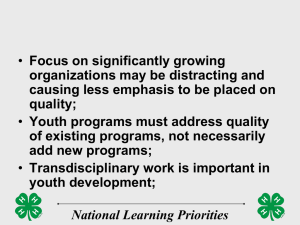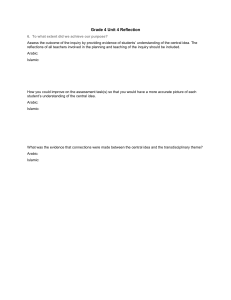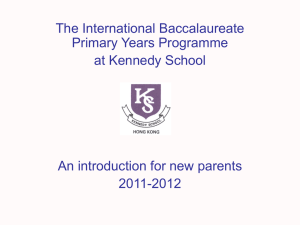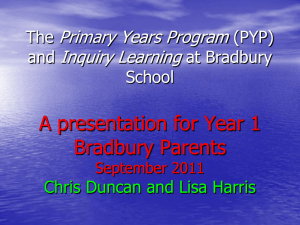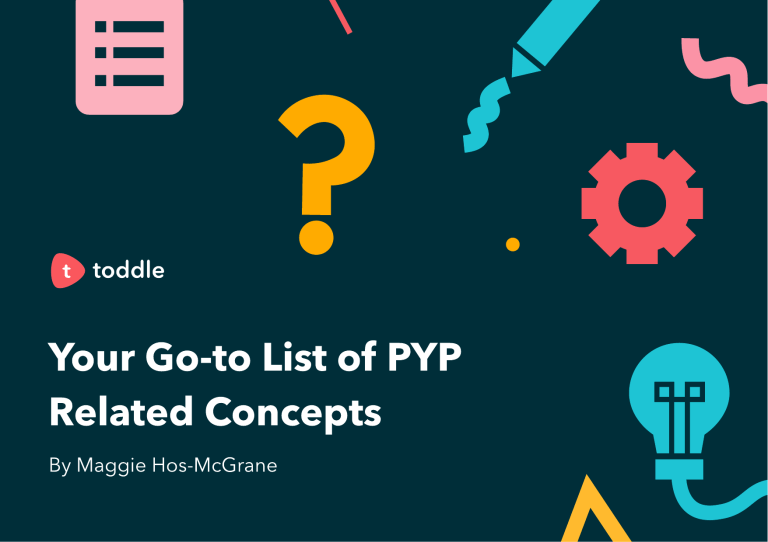
toddle Your Go-to List of PYP Related Concepts By Maggie Hos-McGrane Maggie Hos-McGrane Maggie has been an educator for over 30 years, 25 of these in international schools in Europe and Asia. She has taught students from age 3 to 18 in the IB PYP, MYP and DP programmes and is also an IB consultant, school visitor and workshop leader, facilitating both online, face-to-face regional workshops and in-school workshops. Maggie has presented at international conferences including ISTE, Learning2, ECIS, AASSA and EARCOS, in Asia, Europe, Africa, North and South America. She is passionate about the power of coaching to transform teaching and learning in schools. Disclaimer - The ideas presented in this resource have been developed independently from and are not endorsed by the International Baccalaureate (IB). Where do Related Concepts come from? Related Concepts are often treated as a mystical element of the PYP. Most PYP educators I've worked with wonder where Related Concepts come from and how to use them. The IB PYP documentation, From Principles to Practice states "In the PYP, conceptual understandings are the aim of the unit of inquiry and form the central idea. Related Concepts provide a lens for conceptual understandings within a specific subject. Clearly then, Related Concepts are drawn from subjects. There are currently 6 subject scope and sequence documents and these form a useful starting point for identifying subject-specific Related Concepts. How do the Related Concepts work with the six Transdisciplinary Themes? Related Concepts and the Transdisciplinary Themes go hand-in-hand. To illustrate exactly how, let us walk through my process of creating this list of subject-wise Related Concepts: 1. I started by dividing up the descriptors of the Transdisciplinary Themes. As teachers develop a Unit of Inquiry they focus on a specific part of the descriptor - not the whole thing. The idea is that all parts of the descriptor are addressed throughout the Programme of Inquiry, but in each grade only a small part will form the focus of the units. Therefore, I began creating this tool by first focusing on the descriptors of each Transdisciplinary Theme. These descriptors make the guiding lens of this tool. Figure 6. Learning and Teaching, From Principles to Practice 2. My next step was to look through each of the Scope and Sequence documents, particularly at the strands. I matched these strands to the part of the Transdisciplinary Theme that supported. This information helped create a bridge between the Transdisciplinary Theme and Subjects. This makes up the central column in this tool. Page 11, PSPE Scope and Sequence 3. Finally, I looked deeper into the strands to determine what stood out. This is where I discovered meaningful subject-specific Related Concepts! Page 12, PSPE Scope and Sequence What do you do with Related Concepts? Now that the Related Concepts have been identified, the next question is how to use them! Generally I would choose two of these, or perhaps three with the older students, in order to develop a Central Idea for the unit. For example, let’s take the Where We Are in Place and Time Transdisciplinary Theme, and let’s imagine that a group of teachers have decided the focus will be on the relationship between and the interconnectedness of individuals and civilizations, from local and global perspectives. There are a number of strands from different Scope and Sequence documents that can help build this unit further. Since we are developing a Transdisciplinary unit, I try to ensure that more than one subject is represented, wherever possible. From the Social Studies Scope and Sequence we could look at Continuity and Change through Time, Resources, and the Environment From the PSPE Scope and Sequence documents the Interactions strand might be useful. Related Concepts that teachers might want to use when developing their Central Idea could then be identified as History, Artifacts, Civilizations, Interdependence, Community and so on. It’s time to now look at the table! Descriptor Subject and Strand Related Concepts What I tend to do at that point is to narrow down these Related Concepts and write them on sticky notes so we can move them around easily to wordsmith the Central Idea. In collaborative planning meetings I like to have teachers divide up into pairs, and then using some of the identified Related Concepts, they can have a go at building a number of Central Ideas. These can then be discussed and teachers can decide which Central Idea they want to move forward with. What if you follow State or National Standards? I often get asked during workshops and consultancies about identifying Related Concepts when a school has to follow a specific curriculum mandated by the state or country. To answer this question, let's look at the NGSS Science Curriculum used by many schools around the world. NGSS Standards Grade 2 Step 1: Step 2: Step 3: While planning for Grade 2, one of the topics we see is Earth’s Systems: Processes that Shape the Earth. Now looking at the six Transdisciplinary Themes, this will fit best with How the World Works, and on looking further, we can conclude that it will fall under the part of the descriptor, 'An inquiry into the natural world and it's laws'. Turning back to the NGSS curriculum, we can identify the core ideas for Grade 2 students: The history of planet Earth Earth materials and systems Plate tectonics and large scale system interactions The role of water in Earth’s surface processes Optimizing the design solution. Step 4: Looking at these core ideas it is already possible to identify the Related Concepts: Systems, Plate Tectonics, Processes and so on. These concepts can be used to develop a Central Idea using the same collaborative process outlined in the previous section. In fact the NGSS even suggests a statement that could be the starting point for teachers to develop a Central Idea: 'Patterns in the natural world can be observed'. NGSS Standards Grade 2 The use of the concept pattern here can broaden the unit from just being a science unit, and, for example, it could allow authentic connections with maths. To build a deeper Central Idea we might need to ask questions like: What patterns and cycles can be observed in the natural world and how do they work? These questions would then call upon an understanding of the Key Concepts, Form and Function, which in turn can be used to write the Lines of Inquiry. Why is it important for humans to understand these patterns and cycles (the “so what” question - what would happen if we did not take account of these natural patterns which may lead students into a design thinking challenge). As you can see, we have used Related Concepts to highlight what is essential for students to understand within a discipline. Not only do they deepen disciplinary understanding, the Related Concepts also allow us to build understanding across and between the disciplines, ensuring that our units are truly transdisciplinary. A Quick Guide to Using Related Concepts Decide which part of the descriptor of the Transdisciplinary Theme you are focusing on in a unit. Refer to the Scope and Sequence or other curriculum documents and identify the Related Concepts that can be used to support that focus. Narrow down the Related Concepts until you have 2 or 3 that are most relevant to your inquiry. Use strong verbs to link the Related Concepts into a statement that will form the Central Idea. Your Go-to List of PYP Related Concepts Who We Are Descriptor (An inquiry into) Subject and Strand Related Concepts The nature of self PSPE: Identity Character, Diversity, Ethnicity, Gender, Sexuality PSPE: Identity Spirituality Social studies: Social organisation & culture Beliefs, Values Beliefs and values Wellness, Health, Needs, Nutrition, Exercise, PSPE: Active living Personal, physical, mental, social and spiritual health Relationships including families, friends, Growth, Leisure, Rest PSPE: Identity Spirituality Science: Living things Body systems Social studies: Social organisation and culture communities and cultures PSPE: Interactions Rights and Social studies: Social organisation responsibilities What it means to be human Safety, Growth, Change, Relationships, Energy, and culture Behaviour, Teamwork, Connection, Interaction, Roles, Relationships, Family, Community, Culture, Interdependence Human rights Behaviour, Development, Roles, PSPE: Interactions Belonging, Stereotype, Discrimination, Citizenship, Decisions, Freedom Where We Are in Place and Time Descriptor (An inquiry into) Orientation in place and time Personal histories Homes and journeys The discoveries, explorations and migrations of humankind The relationship between and the interconnectedness of individuals and civilizations, from local and global perspectives Subject and Strand Related Concepts Social Studies: Continuity and change through time Chronology, History Social Studies: Human and natural environments Geography, Borders (natural, social & political), Landscape, Locality, Regions, Settlements, Population, Resources Social Studies: Social organisation and culture Family, Identity, Diversity, Prejudice, Religion, Roles, Traditions, Religion, Conflict PSPE: Identity Heritage Social Studies: Human and natural environments Amenities, Settlement Social Studies: Social organisation and culture Communication, Networks Social Studies: Continuity and change through time Migration Social Studies: Continuity and change through time Discovery, Exploration, Migration, Progress, Conflict Social Studies: Continuity and change through time Civilizations, Innovation, Progress, Revolution, Artifacts, Interdependence Social Studies: Resources and the environment Community, Culture, Justice, Leadership PSPE: Interactions How We Organise Ourselves Descriptor (An inquiry into) Subject and Strand Related Concepts The interconnectedness of human-made systems and communities Social studies: Human systems and economic activities Cooperation, Employment, Product, Transportation The structure and function of organizations Social studies: Social organization and culture Education, Employment Societal decision-making Social studies: Social organization and culture Government, Authority, Legislation, Justice Social studies: Human systems and economic activities Production, Consumption, Transportation, Employment, Process, Supply and demand Social studies: Resources and the environment Resources, Distribution, Poverty, Wealth Economic activities and their impact on humankind and the environment How We Express Ourselves Descriptor (An inquiry into) Ways in which we discover and express ideas, feelings, nature, culture, beliefs and values Subject and Strand Related Concepts Arts Interpretation, Imagination, Technique, Communication, Expression, Experience, Language, Culture, Media, Influence, Meaning, Symbols, Imagery, Structure Language The ways in which we reflect on, extend and enjoy our creativity Arts Performance, Creation, Perspective, Purpose Our appreciation of the aesthetic Arts Audience, Appreciation, Elements, Viewing, Genre, Response, Subjectivity, Opinion How The World Works Descriptor (An inquiry into) Subject and Strand Science: Earth and space The natural world and its laws Science: Materials and matter Science: Living things The interaction between the natural world (physical and biological) and human societies Science: Earth and space Science: Materials and matter How humans use their understanding of scientific principles The impact of scientific and technological advances on society and on the environment Science: Materials and matter Science: Forces and energy Science: Forces and energy Related Concepts Climate, Seasons, Patterns, Systems (Solar, Water cycle, Weather, Body systems), Tectonic plate movement, Renewable and Non-Renewable resources, Energy, Erosion, Geology, Gravity, Materials Animals, Adaptation, Biodiversity, Conservation, Ecosystems, Habitat, Plants, Sustainability Chemical and physical changes Classification, Materials, Structures, Conservation, Discovery Conservation, Efficiency, Forms of energy, Pollution, Power, Technological advances, Transformation Sharing the Planet Descriptor (An inquiry into) Subject and Strand Science: Living things Related Concepts Animals, Plants, Biodiversity, Conservation, Ecosystems, Rights and responsibilities in Habitat, Ecology the struggle to share finite resources with other people and other living things Communities and the relationship within and between them Access to equal opportunities Peace and conflict resolution Resources, Renewable and Non-Renewable Science: Earth resources, Sustainability, Atmosphere, Climate, and space Water, Erosion, Pollution Social studies: Resources Poverty, Wealth, Consumption, and the environment Interdependence, Sustainability Social studies: Resources Equity, Rights, Diversity, Progress, and the environment Technology, Balance, Consequences PSPE: Interactions Peace, Conflict, Perception, Cooperation, Discrimination, Safety Bring teaching teams together to make magic happen Toddle can make a 10x difference at your school - plan collaboratively, assess authentically, foster student agency, and engage families - all from one intuitive interface! Collaborative Planning Assessments and Reports Remote Learning Evidence Collection Portfolios and Projects Family Communication Let's have a chat dk dk dk
